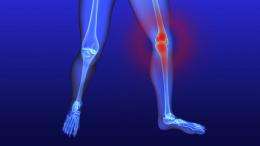knee pain
(PhysOrg.com) -- Complaints about knee pain can be all too familiar when you suffer from osteoarthritis of the knee. The condition often keeps sufferers from participating in many activities—sometimes even just standing.
According to the Arthritis Foundation, osteoarthritis (OA), also called osteoarthroses or degenerative joint disease, is the most common type of arthritis.
OA is a chronic condition characterized by the breakdown of the joint’s cartilage. The breakdown of cartilage causes the bones to rub against each other, leading to stiffness, pain and loss of movement in the joint.
“In clinical trials, new treatments do look very promising,” says researcher Lesley Arnold, MD, a professor of psychiatry and director of the University of Cincinnati (UC) Women’s Health Research Center.
While the majority of Arnold’s research focus is on pain management for conditions such as fibromyalgia and chronic fatigue syndrome, the pain symptoms of OA carry many similarities.
Typically, she says, the pain associated with osteoarthritis of the knee is managed by the use of non-steroidal anti-inflammatory medications with brand names such as Motrin, Advil or Aleve, which target inflammation around the site. New treatment approaches strongly suggest the pain can be medicinally managed from the central nervous system, such as with fibromyalgia, she says.
This broad-based approach could provide relief, without the side effects associated with non-steroidal anti-inflammatory medications (i.e., stomach problems) or blood thinning.
There is no cure for osteoarthritis, but the Arthritis Foundation suggests a number of strategies for OA self-management, including exercise, weight control, realistic goal-setting and self-awareness of your own physical limitations.
But while a healthy lifestyle is important, Arnold and Arthritis Foundation experts agree that some people require pain medication to stay active and control the pain.
Provided by University of Cincinnati


















